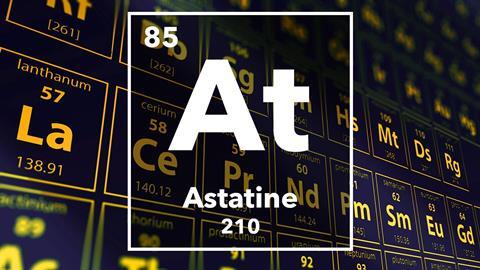Identity.
Astatine (At), atomic number 85, is the rarest naturally occurring
element on Earth. Existing only as the fleeting decay product of
heavier elements, all its isotopes are radioactive with short
lifespans. This elusiveness makes it impossible to obtain a visible
sample, but its position in the periodic table suggests similarities
to halogens like chlorine and iodine. While currently without
practical uses, astatine's potential lies in targeted alpha therapy, a
promising avenue for future cancer treatment research.
History.
The story of astatine begins long before its actual discovery. In
1869, Dmitri Mendeleev, the architect of the periodic table, predicted
the existence of an element occupying the space below iodine. This
hypothetical element, dubbed "eka-iodine," sparked the curiosity of
scientists for decades.
The first attempts to find astatine in nature proved fruitless. In
1939, two separate groups reported possible detections, but their
findings couldn't be conclusively verified. Finally, in 1940, the
elusive element was successfully synthesized at the University of
California, Berkeley. Dale Corson, Kenneth MacKenzie, and Emilio
Segrè bombarded bismuth with alpha particles, creating
astatine-211, the first confirmed isotope. The name "astatine"
comes from the Greek word "astatos," meaning "unstable,"
reflecting the element's inherent radioactivity.
While astatine can be found naturally in trace amounts as a decay
product of heavier elements, the total amount present in the
Earth's crust at any given time is estimated to be less than 30
grams. This makes it the rarest element on Earth, highlighting the
remarkable feat of its artificial creation and the ongoing
challenges in studying its properties.
Usage.
Despite its rarity and short-lived nature, astatine holds potential in
the medical field. The isotope astatine-211 exhibits properties that
make it a promising candidate for targeted alpha therapy, a form of
cancer treatment. Astatine shares similarities with iodine, allowing
it to accumulate in certain tissues like the thyroid gland. This
targeted uptake concentrates the radiation emitted by astatine-211 on
cancer cells, potentially minimizing damage to healthy tissue. While
still in the research stage, astatine's unique characteristics offer
an exciting avenue for future advancements in cancer treatment.
-
Targeted Alpha Therapy: Astatine-211, due to its chemical
similarity to iodine, shows promise in accumulating in specific
tissues like the thyroid gland. This targeted uptake allows
researchers to explore using it in alpha therapy, a form of cancer
treatment that utilizes the destructive power of alpha particles
emitted by radioactive isotopes. The concentrated radiation
delivery potentially minimizes damage to healthy surrounding
tissues.
-
Analytical Tool: Radioactive isotopes can be used as
tracers to monitor the movement of specific elements or compounds
in various systems. Astatine isotopes, though challenging to work
with due to their short lifespans, have been proposed as tracers
for certain elements like rhenium and californium, aiding in
research and analysis.
-
Studying Chemical Reactions: Astatine's unique properties
offer valuable insights into how chemical reactions occur on solid
surfaces. By observing its behavior with different materials,
scientists can gain a deeper understanding of complex surface
reactions, particularly in organic chemistry, potentially leading
to the development of new reaction types and catalysts.
-
Education Demonstrations: Astatine's unique properties and
scarcity make it a fascinating subject for educational
demonstrations in schools and universities. Studying its behavior
and challenges associated with handling such elements can provide
valuable learning experiences for students interested in chemistry
and nuclear science.
Some of the benefits of using Astatine are:
-
Astatine-211's ability to accumulate in specific tissues like the
thyroid gland holds promise for targeted alpha therapy. This
approach concentrates radiation on cancer cells while minimizing
damage to healthy tissue, potentially offering a more precise and
effective treatment compared to traditional methods.
-
Studying astatine's interactions with different surfaces can
provide valuable insights into the mechanisms of complex chemical
reactions, particularly in organic chemistry. This knowledge could
lead to the development of new reaction types and catalysts,
ultimately contributing to advancements in various fields.
-
Astatine isotopes, despite their short lifespans, have potential
as tracers for specific elements like rhenium and californium.
These tracers can be used to monitor the movement of these
elements in various systems, aiding research and analysis in
fields like environmental science and material science.
-
Astatine's unique properties and challenges associated with its
handling make it a valuable subject for educational
demonstrations. Studying its behavior can provide students with
engaging learning experiences, fostering interest in chemistry,
nuclear science, and the complexities of scientific research.
